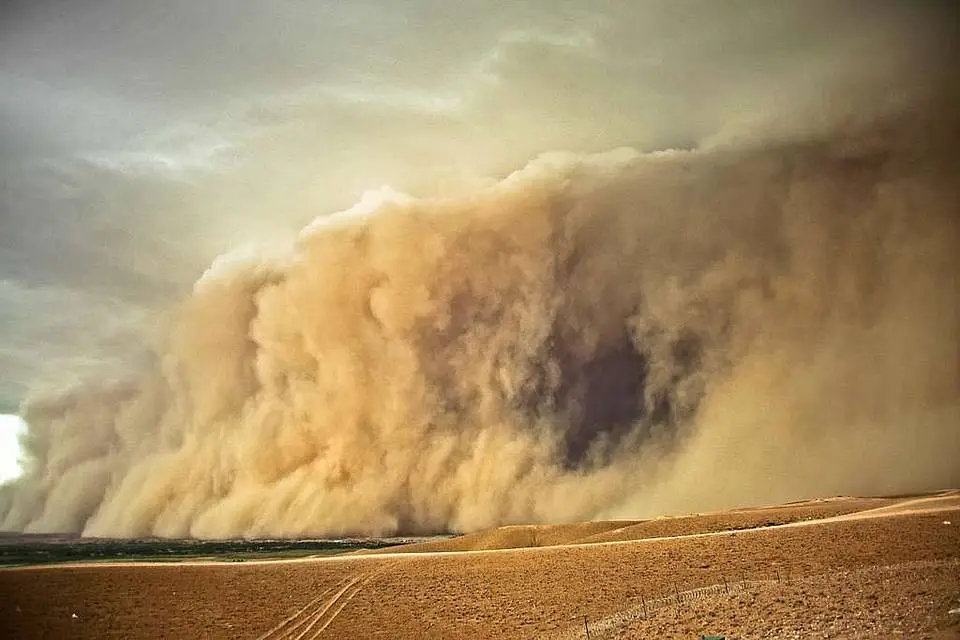Sand and Dust Storms Are a Growing Global Crisis Affecting 330 Million People

Recent findings from the WMO Airborne Dust Bulletin reveal that sand and dust storms have emerged as a significant threat to global health and economic stability. These meteorological phenomena currently impact approximately 330 million individuals across over 150 nations worldwide.
Understanding Global Dust Distribution
In 2024, global average surface dust concentration measured 12.5 μg m⁻³, representing a marginal decrease from the previous year’s 12.7 μg m⁻³. However, this modest reduction masks substantial regional variations, revealing a complex global distribution pattern.
Chad in north-central Africa recorded the most severe dust concentrations, with annual average surface levels reaching 800-1,100 μg m⁻³. These extreme readings occur primarily in the Bodélé Depression, recognized as one of Earth’s most prolific dust source regions. Meanwhile, the southern hemisphere’s highest concentrations appear in central Australia and South Africa’s western coastline, with levels spanning 150-300 μg m⁻³.
Atmospheric circulation patterns demonstrate dust storms’ remarkable transport capabilities, with particles traveling hundreds to thousands of kilometers from their origins. Key long-range transport corridors include the northern tropical Atlantic pathway linking West Africa to the Caribbean and South America, the Mediterranean basin, the Arabian Sea, the Bay of Bengal, and central-eastern China.
Public Health Implications
The health consequences of sand and dust storms have reached alarming proportions. Joint research conducted by the World Meteorological Organization and World Health Organization indicates that 3.8 billion people—nearly half of humanity—experienced dust exposure exceeding WHO safety thresholds between 2018 and 2022. This figure represents a 31 percent increase from the 2.9 billion affected during 2003-2007.
Exposure patterns vary dramatically across different regions. While certain areas encounter dust storms sporadically for just a few days annually, the most severely impacted regions experience dust exposure during more than 87 percent of days, equating to over 1,600 days within a five-year span. Such persistent exposure leads to significant respiratory ailments and cardiovascular complications, particularly among vulnerable populations including children, the elderly, and individuals with pre-existing medical conditions.
Economic Consequences
The financial ramifications of sand and dust storms extend far beyond immediate healthcare expenditures. United States-focused research provides valuable insights into these economic impacts. In 2017, dust and wind erosion inflicted approximately 154 billion dollars in economic damage—more than quadruple the losses calculated for 1995.
These costs encompass diverse sectors including household expenditures, agricultural losses, diminished wind and solar energy efficiency, mortality costs from fine particulate exposure, healthcare expenses related to Valley fever, and transportation disruptions. The true economic burden likely exceeds these estimates, as many impacts remain unquantified due to insufficient data regarding aviation effects, rangeland agriculture, and hydrological cycle disruptions.
Notable Regional Events from 2024
Several significant dust storm episodes throughout 2024 illustrate the varied manifestations of this global challenge. The Canary Islands experienced a major dust outbreak in December, triggered by high-pressure systems over Algeria that generated Harmattan winds, transporting Saharan dust northward. This event particularly impacted ground-level concentrations in populated areas.
East Asia documented 14 sand and dust storm events during 2024, with ten occurring in spring months. A particularly intense late March episode involved a powerful Mongolian cyclone generating winds exceeding 24 meters per second, carrying dust from southern Mongolia to densely populated regions including Beijing, where PM₁₀ concentrations surpassed 1,000 μg m⁻³ and visibility fell to one kilometer.
An uncommon summer dust storm in June affected Beijing and northern China, highlighting the growing frequency of such events during traditionally quieter seasons. Inadequate vegetation growth resulting from elevated spring temperatures and drought conditions in Mongolia contributed to this unusual occurrence, demonstrating the relationship between climate change and dust storm frequency.
West Asia witnessed an extraordinary winter dust storm in December impacting Iraq, Kuwait, Qatar, and the Arabian Peninsula. This event caused extensive social and economic disruption, including flight cancellations, school closures, and postponement of public gatherings, illustrating dust storms’ wide-ranging effects on daily life and economic activities.
The World Meteorological Organization has enhanced its monitoring and forecasting capabilities through the Sand and Dust Storm Warning Advisory and Assessment System, which coordinates international research and maintains operational regional centers. These efforts concentrate on improving early warning systems, developing evidence-based guidance for sustainable land management, and supporting reforestation initiatives.
The United Nations has designated 2025-2034 as the Decade on Combating Sand and Dust Storms, emphasizing the necessity for coordinated global action. This initiative seeks to prevent, halt, and reduce sand and dust storms’ detrimental impacts through collaborative efforts involving multiple stakeholders and voluntary funding mechanisms.
Sand and dust storms have increased in frequency and severity throughout the Indian subcontinent, especially in northern and northwest areas like the Indo-Gangetic Plain, Rajasthan, Haryana, and Uttar Pradesh. The main sources of dust are the Thar Desert and arid regions, which are frequently damaged by land mismanagement, overgrazing, and deforestation. According to the 2025 WMO Bulletin, favourable weather and fewer emissions from dust-active areas are probably the reasons why northern India’s surface dust concentrations were lower in 2024 than in prior years. Nonetheless, India’s closeness to the Thar Desert, high population density, and urbanisation continue to make it extremely vulnerable. Reducing the socioeconomic and health effects of these dangers would require strengthening India’s early warning systems, land use regulations, and regional collaboration.
Read the full report here.
